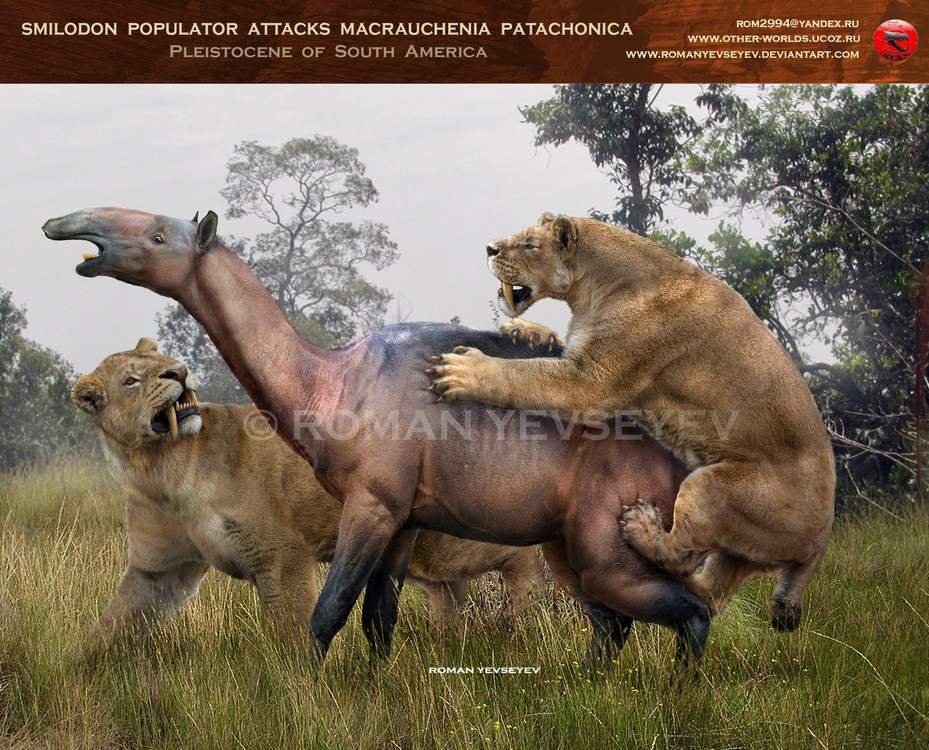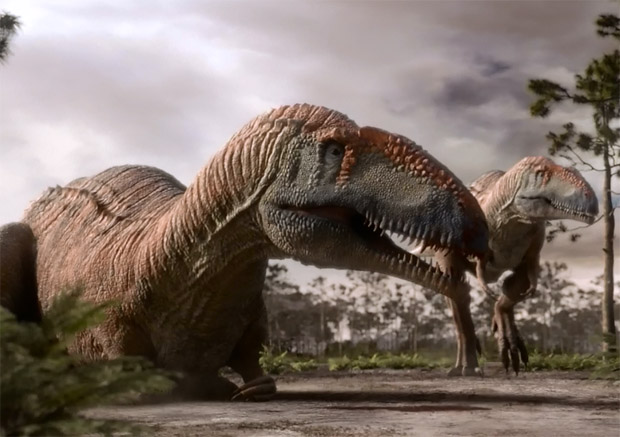Post by dinosauria101 on Aug 3, 2019 15:21:28 GMT 5
Smilodon populator (pride of 12)
Smilodon, often called a sabertoothed cat or wrongly a saber-toothed tiger, is an extinct genus of machairodonts. This saber-toothed cat was endemic to North America and South America, living from near the beginning through the very end of the Pleistocene epoch (2.5 mya—10,000 years ago). Smilodon populator ("Smilodon the Devastator"), 1 million-10,000 years ago; occurred in the eastern parts of South America and was the largest species of all machairodonts. It was much larger than its cousins, S. fatalis and S. gracilis, possessing a massive chest and front legs, and is the largest known variety of saber-toothed cat. It was more than 1.40 m (55 in) high at the shoulder, 2.6 m (100 in) long on average and had a 30 cm (12 in) tail. Smilodon populator was substantially heavier and larger than any extant felid, with a body mass range of 220–360 kg. Particularly large specimens of S. populator almost certainly exceeded 400 kg in body mass. Its upper canines reached 30 cm (12 in) and protruded up to 17 cm (6.7 in) out of the upper jaw. Genetic evidence suggests that Smilodon populator and other members of the genus diverged from the main lineage of modern cats (subfamily Felinae) around 14-18 million years ago.

Mapusaurus roseae
Mapusaurus ("Earth lizard") was a giant carnosaurian, Carcharodontosaurid dinosaur from the early Late Cretaceous (late Cenomanian to early Turonian stage) of what is now Argentina and possibly Chile. It was roughly similar in size to its close relative Giganotosaurus, averaging about 12.4 meters and 7 tonnes and getting to 13.6 meters long and 8.5 tonnes at maximum. The longest individual for which Coria and Currie (2006) provided a concrete estimate in Table 1 (apendix lll) is the animal to which femur MCF-PVPH-208.203 belonged; this individual is estimated as 10.2 metres (33 ft) long, but it is a juvenile. The fossil remains of Mapusaurus were discovered in a bone bed containing at least seven individuals of various growth stages. Coria and Currie speculated that this may represent a long term, possibly coincidental accumulation of carcasses (some sort of predator trap) and may provide clues about Mapusaurus behavior. Other known theropod bone beds include the Allosaurus-dominated Cleveland-Lloyd Dinosaur Quarry of Utah, an Albertosaurus bone bed from Alberta and a Daspletosaurus bone bed from Montana. Paleontologist Rodolfo Coria, of the Museo Carmen Funes, contrary to his published article, repeated in a press-conference earlier suggestions that this congregation of fossil bones may indicate that Mapusaurus hunted in groups and worked together to take down large prey, such as the immense sauropod Argentinosaurus. If so, this would be the first substantive evidence of gregarious behavior by large theropods other than Tyrannosaurus, although whether they might have hunted in organized packs (as wolves do) or simply attacked in a mob, is unknown.

Credit to Wikipedia
Smilodon, often called a sabertoothed cat or wrongly a saber-toothed tiger, is an extinct genus of machairodonts. This saber-toothed cat was endemic to North America and South America, living from near the beginning through the very end of the Pleistocene epoch (2.5 mya—10,000 years ago). Smilodon populator ("Smilodon the Devastator"), 1 million-10,000 years ago; occurred in the eastern parts of South America and was the largest species of all machairodonts. It was much larger than its cousins, S. fatalis and S. gracilis, possessing a massive chest and front legs, and is the largest known variety of saber-toothed cat. It was more than 1.40 m (55 in) high at the shoulder, 2.6 m (100 in) long on average and had a 30 cm (12 in) tail. Smilodon populator was substantially heavier and larger than any extant felid, with a body mass range of 220–360 kg. Particularly large specimens of S. populator almost certainly exceeded 400 kg in body mass. Its upper canines reached 30 cm (12 in) and protruded up to 17 cm (6.7 in) out of the upper jaw. Genetic evidence suggests that Smilodon populator and other members of the genus diverged from the main lineage of modern cats (subfamily Felinae) around 14-18 million years ago.

Mapusaurus roseae
Mapusaurus ("Earth lizard") was a giant carnosaurian, Carcharodontosaurid dinosaur from the early Late Cretaceous (late Cenomanian to early Turonian stage) of what is now Argentina and possibly Chile. It was roughly similar in size to its close relative Giganotosaurus, averaging about 12.4 meters and 7 tonnes and getting to 13.6 meters long and 8.5 tonnes at maximum. The longest individual for which Coria and Currie (2006) provided a concrete estimate in Table 1 (apendix lll) is the animal to which femur MCF-PVPH-208.203 belonged; this individual is estimated as 10.2 metres (33 ft) long, but it is a juvenile. The fossil remains of Mapusaurus were discovered in a bone bed containing at least seven individuals of various growth stages. Coria and Currie speculated that this may represent a long term, possibly coincidental accumulation of carcasses (some sort of predator trap) and may provide clues about Mapusaurus behavior. Other known theropod bone beds include the Allosaurus-dominated Cleveland-Lloyd Dinosaur Quarry of Utah, an Albertosaurus bone bed from Alberta and a Daspletosaurus bone bed from Montana. Paleontologist Rodolfo Coria, of the Museo Carmen Funes, contrary to his published article, repeated in a press-conference earlier suggestions that this congregation of fossil bones may indicate that Mapusaurus hunted in groups and worked together to take down large prey, such as the immense sauropod Argentinosaurus. If so, this would be the first substantive evidence of gregarious behavior by large theropods other than Tyrannosaurus, although whether they might have hunted in organized packs (as wolves do) or simply attacked in a mob, is unknown.

Credit to Wikipedia





